Dish
Chinese

Description
Subject Matter:
By the Western Han dynasty, basic household bowls, plates, basins, jars, etc. were produced in great quantity, not only for use in daily life, but also specifically for tombs as mingqi (明器), literally "bright objects", or grave goods, as a way to provide for the deceased. These mingqi included everything one would need during the afterlife, naturally, these objects reflected daily life during the Han. Mingqi could include houses, towers, gates, granaries, livestock pens, chicken coops, wells, cooking stoves, storage vessels, dishes, incense burners, lamps and figures such as horses, dogs, anthropomorphic animals, and people such as officials, guardians, servants and entertainers, and more. The number of ceramic mingqi items in a tomb could reach numbers of a few to several hundred objects. Bowls or basins such as this would have been widely used by almost every stratum of society.
Physical Description:
Red earthenware, flat bottomed bowl with rounded sides and thick rim, molded with wave pattern to exterior wall, covered in amber and green lead glaze, with iridescence and calcification.
Usage Rights:
If you are interested in using an image for a publication, please visit https://umma.umich.edu/request-image/ for more information and to fill out the online Image Rights and Reproductions Request Form.